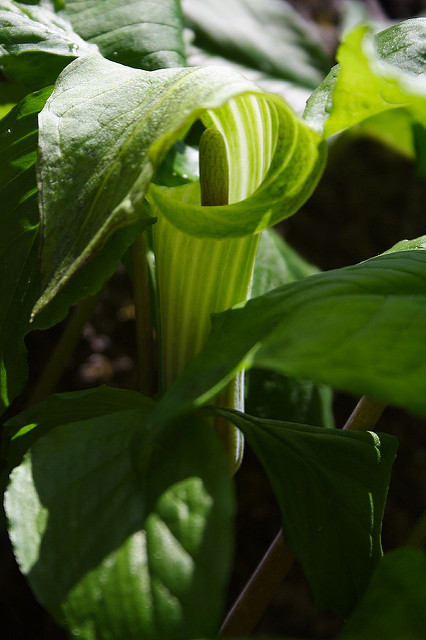Close your eyes and picture your favorite flower. Maybe you see a bright red flower that blooms in your garden in early June, or maybe it’s a sweet smelling purple flower that covers the bushes in your yard in May.
When I close my eyes, I see a common, yet odd-looking plant. It’s green, with streaks of maroon running down its sides and three large leaves that cover the plant like an umbrella. Instead of petals it has a spathe, a leaf-like structure that wraps around the stem to form a pitcher. If you pull back the hood covering the pitcher, you’ll find the spadix, a club-like structure covered in tiny little flowers. It’s “Jack” hidden inside his pulpit.
Jack-in-the-Pulpits grow in moist, shady deciduous forests and start to appear in late March to early April. During my backpacking trips in late May I make sure to point out the little pulpits to my students and once they can identify them I challenge them find as many as they can. This past spring, we counted over 150 individuals over the span of two days, a record for that section of trail.

A Jack-in-the-Pulpit hidden among the plants. Photo by Jennifer Schlick
When I first point out Jack-in-the-Pulpit, people often compare it to a Pitcher Plant. Based on its shape I can understand why people make the connection, but I’m quick to remind people that just because plants look similar does not mean that their parts have the same function. Pitcher Plants have a pitcher-like shape to capture and consume small insects. They are carnivorous. Jack-in-the-Pulpits, on the other hand, are not. Their spathe is used to funnel small insects, like flies and gnats, into the plant to pollinate the flowers.
In late summer, after the female plants have been pollinated, the leaf-like spathe disintegrates and reveals a cluster of red berries along the spadix. Each berry contains one to five seeds and sources say it has the consistency of a tomato. How do they taste, you might ask? Well, I couldn’t tell you and I doubt you could find someone that could. The entire plant, including the berries, are inedible to humans.
When I was in college I had professor that claimed to have eaten a piece of Jack-in-the-Pulpit. According to him, after trying a tiny sample of the plant he immediately got an extremely painful, burning sensation in his mouth and his throat. He survived to tell the tale and even taste-tested the plant for a second time before deciding to call it quits. It should go without saying, but I’ll say it anyways — please don’t try this at home.
The burning sensation that my professor experienced was caused by calcium oxalate, a microscopic, needle-like crystal found in plant tissues and organs. Scientists believe the main function of this crystal is to regulate calcium levels, but a more obvious secondary function is protection from grazing animals like deer. These needles not only cut flesh, they also inject harmful toxins that can cause painful blisters. If too much of the plant is consumed, the blisters caused by the crystals can swell and lead to choking and in extreme cases suffocation.
Jack-in-the-Pulpits aren’t the only plants that use calcium oxalate to regulate calcium and deter deer. In fact, Skunk Cabbage, a close relative to Jack-in-the-Pulpits and a very common plant at Audubon, contains the same substance. While their great big leaves look perfect for deer to munch on, one bite will cause the same painful burning sensation as Jack-in-the-Pulpits.
While Jack-in-the-Pulpits are not as flashy and colorful as other flowers in our area, these amazing plants are able to protect themselves from one of the biggest threats to our understory plants, deer. Maybe that’s why they’re one of my favorite plants to find.
Margaret Foley is a Naturalist at Audubon Community Nature Center.
Audubon Community Nature Center builds and nurtures connections between people and nature. ACNC is located just east of Route 62 between Warren and Jamestown. The trails are open from dawn to dusk as is Liberty, the Bald Eagle. The Nature Center is open from 10 a.m. until 4:30 p.m. daily except Sunday when it opens at 1 p.m. More information can be found online at auduboncnc.org or by calling (716) 569-2345.


Recent Comments